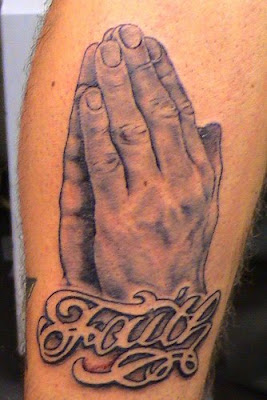



Early Christian drawings or paintings of persons engaged in the act of prayer do not show them with their hands, palms together, raised slightly in front of them. In fact, this manner of praying is conspicuously absent. In the Christian wall paintings of the Roman catacombs, the dominant form of prayer shown is that of the orans position, standing with the hands spread in front and the palms facing up. It is a position still widespread in the iconography of the Eastern Christian churches and it was also described in Greek and Aramaic texts referring to Jewish prayer. As used in the catacombs, it has been interpreted both as a prayer position that suggested thanksgiving for being delivered from death and an earnest supplication to God for merciful judgement of the departed soul. However, if this shared position of prayer was so widespread and in use so early, where and when does the version in our tattoo become prevalent, at least in western Christianity?
Our only real clue, as faint and threadbare as it may be, is the following line from the Annals of the Kingdom of Franks, likely written by a scribe named Einhard (c. 775 to 850 AD), where he says that Duke Tassilo of Bavaria swears his allegiance to Pippin in 757 AD: "commending himself in vassalage between the hands." Because such commendation ceremonies were actually painted in later history, we know that "between the hands" refers to the hand positions of the lord and vassal. The vassal would kneel before the lord in submission, with his hands, palms together, stretched out to the lord in front of him. The lord would then place his hands over the vassals hands, between his own, to indicate not only his acceptance of the vassal but also his dominance over him.
By the 15th century, this method of prayer was securely part of western Christian iconography. In the San Marco monastery of Florence, Fra Angelico (a Dominican friar and painter) was commissioned by Cosimo de' Medici to paint a series of 43 frescoes that acted as a guide to the spiritual life. Not surprisingly, prayer figures largely, but in particular we see that Saint Dominic is painted kneeling in front of the crucifix, with his palms together in front, in a codified gesture of prostration meant to invoke an attitude of humility. In theory and in practice, this particular gesture had become an expected part of the ritual repertoire. As marvelous as these frescoes are, we must turn to another artist of this period for the exact image in our tattoo design.
